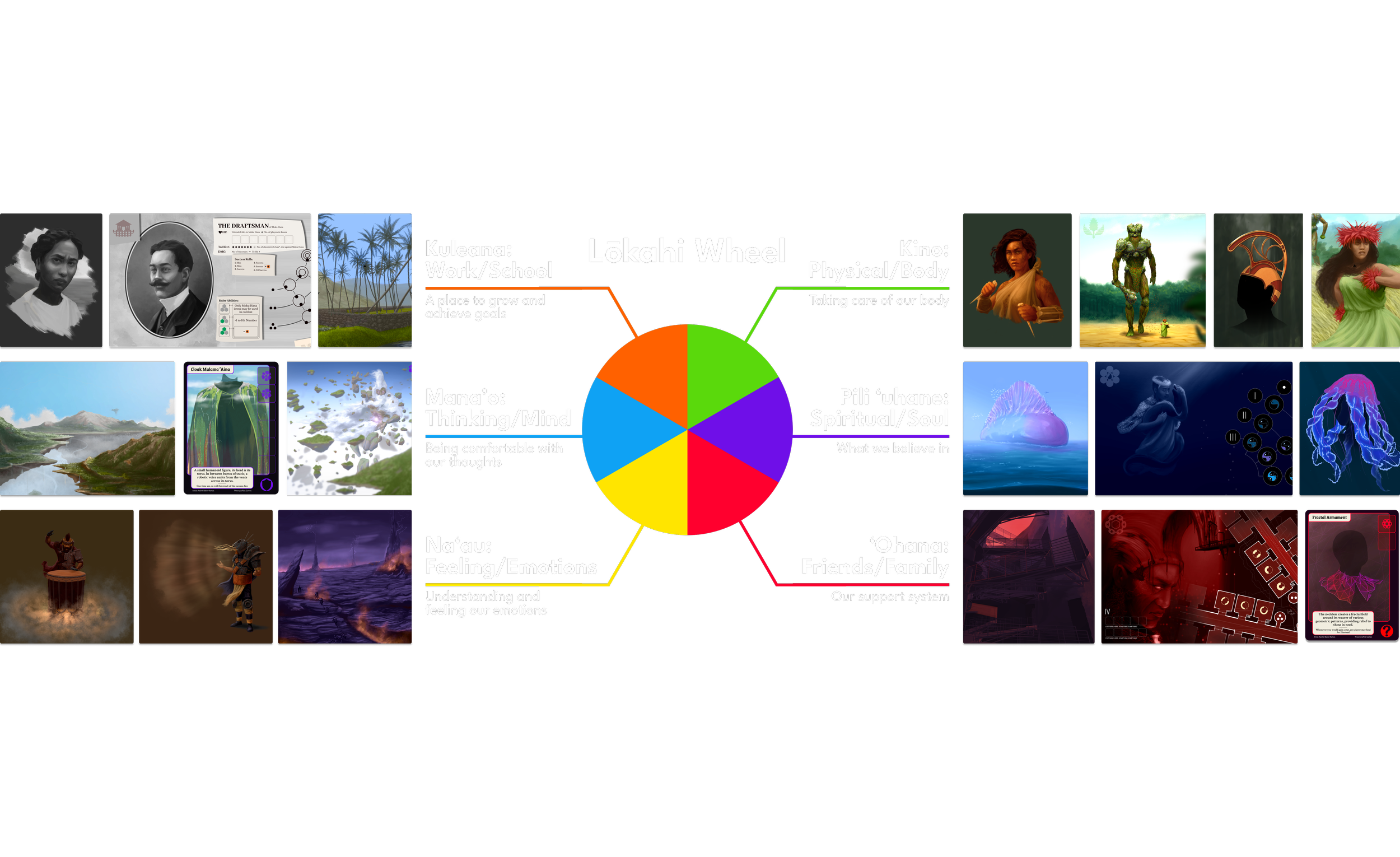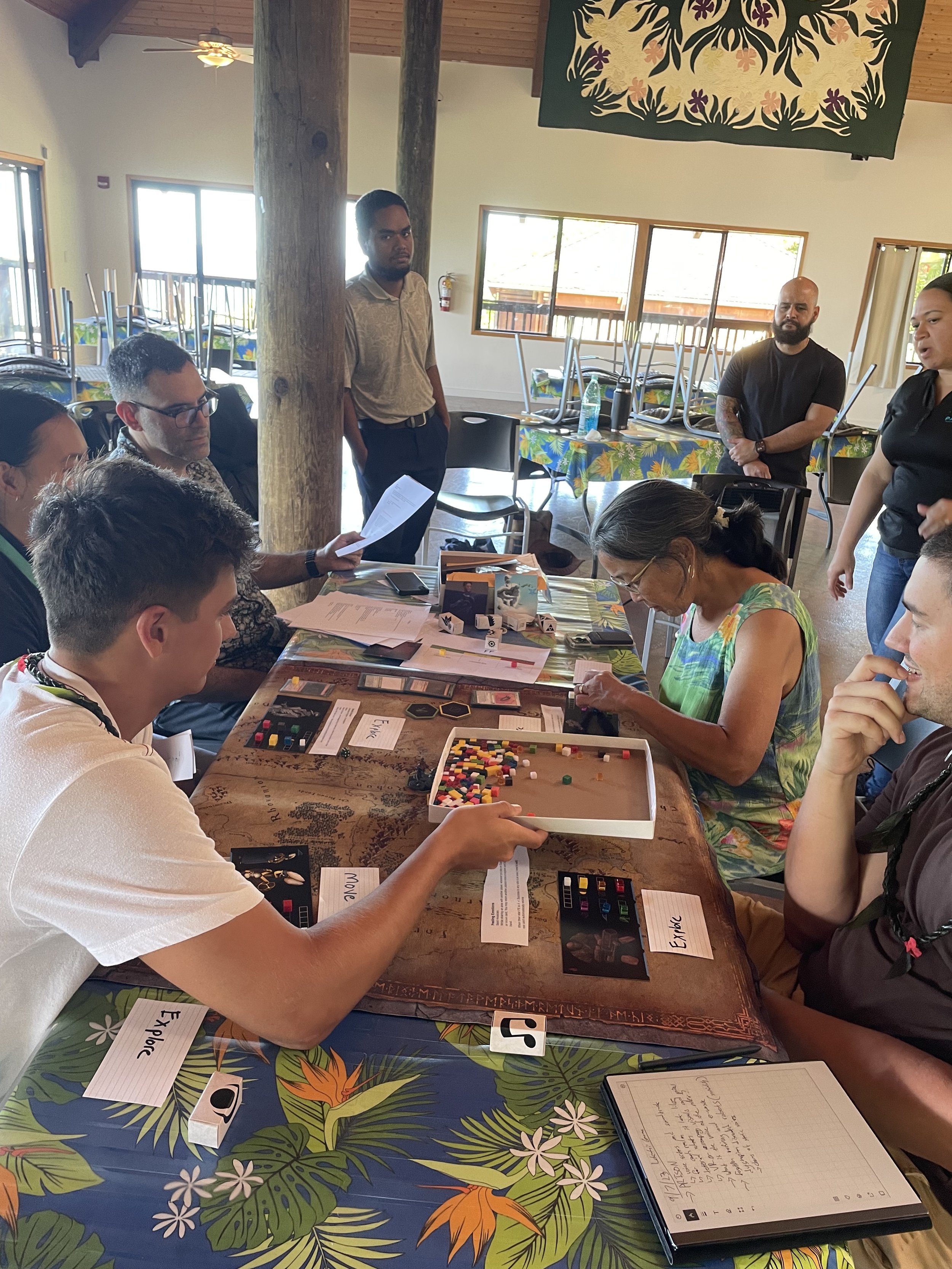
Kaona
Empowering Health Literacy via a Tabletop Role-Playing Game and Mobile "Storytelling" Application, Inspired by Hawaiian Haʻi Moʻolelo (Storytelling)
Jan 2023 - Present | My Role: UX Designer and Artist
Kaona is a collaboration between Theorycraftist Games, the Pacific Alliance Against COVID-19 (PAAC) team at the Waianae Coast Comprehensive Health Center (WCCHC), and the Ka Moamoa Lab at Georgia Tech.
Kaona* is a four-player tabletop RPG and mobile “storyteller” app, designed to foster youth wellbeing from a Kānaka Maoli (Native Hawaiian) perspective, by introducing the values of lōkahi (harmony).
The game takes place in post-apocalyptic moku (realms) that have fallen out of harmony, representing the six domains of the lōkahi wheel. Their environment, characters, and quests are inspired by Hawaiian moʻolelo (stories and legends), Hawai`i’s history, and life experiences relatable to youth in Wai`anae.
Players work together to restore lōkahi in the moku by completing quests and healing corrupted rulers. Kaona’s storyteller app immerses players in the stories and guides first-time RPG players.
Kaona’s collaborative gameplay fosters skills in problem-solving, self-reflection, and community-building. The game’s moʻolelo, history, and place-based references enable players to mirror situations within their lives and develop approaches to navigate real-life challenges.
*Kaona can be defined as a hidden meaning, or double meanings that signify good or bad fortune. Inoa, or name, holds mana (spiritual power) and is important in identifying intention and purpose.
A Wellness Crisis
Native Hawaiian and other Pacific Islander (NHPI) youth are experiencing a crisis of well-being - increased depression, anxiety, social isolation, and poor school performance - fueled by structural inequities in healthcare, the generational trauma of colonialism, and the COVID-19 pandemic.
During the pandemic, NHPI youth experiences dramatic disruptions in everyday life, while facing high rates of infection, morbidity, and mortality, especially in rural areas such as our community of focus: Waiʻanae and the Leeward coast of Oʻahu.
Kaona is a response to this context, providing novel ways to restore well-being and peer-to-peer connection.
Centering Hawaiian Values in Game-Based, Narrative-Based Learning
Game-based and narrative-based learning are promising approaches to addressing wellness concerns, especially for Indigenous communities with deep storytelling practices. Kaona takes a de-centering approach to incorporating traditional practices into learning: uplifting Hawaiian ways of knowing and de-centering Western models of health. This approach is guided by the `Ōlelo No`eau (Hawaiian Proverb):
“I ka wā ma mua, i ka wā ma hope”
(“we look to the past as a guide to the future“)
This proverb illustrates how looking into the past allows learning from ancestral knowledge and brings hope for the future. For Kānaka Maoli and Kama`āina (those who grew up in Hawai`i), this reflection comes through mo‘olelo: the stories and legends crucial to Hawaiian culture, displaying how the community builds knowledge.
The Lōkahi Wheel
Kaona’s core pedagogy is rooted in the Hawaiian value of lōkahi, emulating the Lōkahi Wheel wellness model* which depicts six domains of health. The Lōkahi wheel promotes the balance of these domains, meaning that wellness is interconnected, both within oneself and one’s community, making introspection and community-building key learning goals of Kaona.
*The Lōkahi Wheel was developed by Kamehameha Schools, a private school system in Hawai`i, that offers Hawaiian culture-based education, giving preference to students of Hawaiian ancestry
Community-Engaged Game Dev
Community-engaged game dev encourages co-design and collective knowledge building, resulting in games that are attuned to the community-of-focus. Throughout Kaona’s development, we have hosted 9+ community engagement sessions (10-20 participants each), at schools and community health centers on the Leeward coast of O‘ahu. We gathered community and student insights through:
Play-testing sessions
of 1 to 3 moku
Storytelling sessions
on narrative & quests
Co-design sessions
of items & worldbuilding
Frequent engagement sessions allows us to rapidly iterate on Kaona, addressing issues as soon as they emerged, proactively integrating community perspectives, and ultimately ensuring Kaona is a positive and authentic experience for Kānaka Maoli and Kama‘āina youth.

World-building & Quests
In the world of Kaona, each Lōhaki wheel domain manifests as a moku (realm), representing what imbalance looks like in its corresponding Lōkahi domain. These moku - their environment, inhabitants, rulers, and quests - are inspired by Hawaiian mo‘olelo and history, and place-based references relatable to Wai‘anae youth.

For example, the Work & School domain becomes Moku Hana, a simulation that traps the players in the Waiʻanae coast in the 1880s, when Western business interests dominated the communities. Each moku contains quests that the players must work together to complete.
Game Art & Visual Design
Design Consideration: Six Realms, One Game
Each moku has distinct art and visual/UI design, reflecting the cultures of these realms while delivering a cohesive overall gaming experience. The art conveys the six moku to the players, often mirroring familiar landscapes, legendary Hawaiian figures, and historical references.
Codesign
During co-design sessions on item and rulebook art, students were prompted with summaries of moku and items’ abilities. Students drew/penned each itemʻs look, function, feel, and significance. We included generated ideas as direct scans or inspiration for art.
Moku-Specific UI
The UI design was a delicate balance of functionality and aesthetic appeal, prominently featuring art while easily presenting needed information. Using the design system colors and icons, each moku is distinct, making it easy for players to recognize which moku a game element is part of.
This approach, first used with the item cards, set a standard for the game's UI, ensuring both cohesion and distinctiveness for each moku.
Tile and Quest System Enhancement
The game's tile and quest system, initially differentiated by three bright colors, was refined with a new frame concept. This introduced dot indicators for grouping tiles, making world associations clear and intuitive. This subtle design choice improved visual consistency and gameplay comprehension.
Quest Chart Design
Transforming the standard quest charts, the new design integrated the gameplay mechanics with the thematic elements of each world. For example, in the Friends and Family world, themed as a prison, the quest chart was reimagined as a prison floor plan. This innovative approach significantly enhances the player experience.
Application Design
Design Consideration: A Diverse Range of Players and Classroom Use
An inclusive gaming experience is critical for Kaona, given its broad audience within a high school classroom. Novice gamers may perceive games as not "for" them, hindering their engagement. This is problematic in educational settings where engagement is crucial for learning. By making Kaona accessible and enticing for all skill levels, we aim to eliminate barriers to participation, ensuring it serves its educational purpose effectively., engaging novice and expert gamers alike.
To address the needs of those unfamiliar with gaming or "DMing," we're implementing a digital "DM" assistant. This assistant will guide players through quests and enrich the experience with narrated stories and soundscapes for each moku, fostering an immersive and welcoming environment for every player.
Concept Sketches
We considered a hand-held version of this app, that can be used by each player on their personal phone.
While a familiar use, we found that a hand-held use-case could lead to distraction, and had too many unknowns, if we require that each player have a reliable phone.
To minimize distraction, and increase the sense that the app is another artifact within the game world, we are pursuing a table-top use for the mobile app, which only requires one phone, and is optimized for horizontal usage.
In Progress: Wireframes
Game Intro
The game intro provides players with just enough info for them to understand why theyʻre transported to Kaona, and for selecting their characters. Weʻre exploring a narrative of being called by an “Ancestor”, to heal the “distortion” in Kaona - with the looming threat of distortion spreading into our world, if the distortion is not stopped.
Entry Sequence
The entry sequence guides players through setting up the board, in a manner that keeps players immersed. The Ancestor tells players they need to place the necessary pieces in a certain formation, to initiate their journey to Kaona.
Lōkahe Wheel - Main Navigation
The main navigation screen in the app is a pad-lock type wheel, that represents each moku (realm) and their corresponding 9 quest symbols.
To ensure the app does not become the primary focus of the game, it does not hold all the necessary information for players to explore quests. Players must use the quest charts to determine which quest symbol is appropriate.
Findings so far…
Semi-formal interviews of team members reveal the potential for meaningful student engagement through culturally-rooted and place-based elements and the pedagogical impact of collaborative gameplay in modifying student behavior towards peer-to-peer communication and group problem-solving.
Cultural Relevance Improved Player Engagement
Students resonated with the culturally revitalizing and place-based aspects of Koana, improving student engagement and pedagogical function.
When students interacted with a quest in Moku Hana, the moku set in 1880s Waiʻanae, students immediately recognized the parallels to their home and became more interested in the quest details. Students also showed excitement over the characters, such as how the characters reflected Hawaiian gender identities. P2 (Game Artist) noted that this resonating quality, in combination with fantasy representation, seemed to be what drew students in the most.
Collaborative Gameplay Modified Player Behavior
Kaona’s collaborative gameplay shifted students’ behavior from individual competition to collaboration. P1 (Game Developer) described this as Kaona’s “self regulating” nature, as it reinforced player collaboration, even modifying behavior of highly competitive gamers, as there was social pressure not to ruin the game for the group.
Players typically began with very competitive attitudes; both P4 and P3 emphasized how students “did not want to work together,” instead trying to complete quests on their own. However, player strategies changed towards collaboration as they realized the increased potential of collaborative moves, along with the game’s penalty for not working together: if one person “dies,” then everyone does, restarting the game.
Reflection
Cultural Humility and Respect: This project was the first project I was part of in the Ka Moamoa Lab, and my first project with groups in Hawaiʻi. My experience working at Veggie Mijas, a Latine food justice organization, emphasized the importance of cultural relevancy and de-centering Western perspectives. However, the work at VM was within my own community and Kaona presented my first experience along the same themes, but as an outsider to the community of focus - Native Hawaiians.
Artistic Growth: This project has significantly spurred my growth as an artist. Collaborating with Alika, the incredibly talented primary game artist on this project, has challenged me to learn quickly, adapt, and push the boundaries of my illustrative skills, allowing me to create some pieces that I never thought I could!
Game Design and Worldbuilding: In addition to artistic growth, this project has provided valuable experience in game design and worldbuilding. The process of creating an immersive game has been a rich learning adventure, expanding my understanding of how to craft engaging experiences for players and shape intricate game worlds.

















